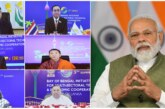Recent years have registered rapid demand in electricity demand in India, and the 900 billion kilowatt hours produced in 2009 was more than triple the 1990 output, though still represented only some 750 kWh per capita for the year. With huge transmission losses, this resulted in only about 650 billion kWh consumption. Coal provides 68% of the electricity at present, but reserves are limited. Gas provides 12%, hydro 12%. The per capita electricity consumption figure is expected to double by 2020, with 6.3% annual growth, and reach 5000-6000 kWh by 2050, requiring about 8000 TWh/yr then.
In 2006 almost US$ 9 billion was committed for power projects, including 9.35 GWe of new generating capacity, taking forward projects to 43.6 GWe and US$ 51 billion. In late 2009 the government stated that it was confident that 62 GWe of new capacity would be added in the 11th 5-year plan to March 2012, and best efforts were being made to add 12.5 GWe on top of this.
At the end of 2011, 180 GWe was on line. The government’s 12th 5-year plan for 2012-17 was targeting the addition of 100 GWe over the period. Three quarters of this would be coal- or lignite-fired, and only 3.4 GWe nuclear, including two imported 1000 MWe units at one site and two indigenous 700 MWe units at another. By 2032 total installed capacity of 700 GWe is planned to meet 7-9% GDP growth, and this was to include 63 GWe nuclear.
A KPMG report in 2007 said that India needed to spend US$ 120-150 billion on power infrastructure over the next five years, including transmission and distribution (T&D). It said that T&D losses were some 30-40%, worth more than $6 billion per year. A 2010 estimate shows big differences among states, with some very high, and a national average of 27% T&D loss, well above the target 15% set in 2001 when the average figure was 34%.
Nuclear power Supply
Nuclear power supplied 20 billion kWh (3.7%) of India’s electricity in 2011 from 4.4 GWe (of 180 GWe total) capacity and after a dip in 2008-09 this is increasing as imported uranium becomes available and new plants come on line. Some 350 reactor-years of operation had been achieved by the end of 2011. India’s fuel situation, with shortage of fossil fuels, is driving the nuclear investment for electricity, and 25% nuclear contribution is the ambition for 2050, when 1094 GWe of base-load capacity is expected to be required. Almost as much investment in the grid system as in power plants is necessary.
The target since about 2004 has been for nuclear power to provide 20 GWe by 2020, but in 2007 the Prime Minister referred to this as “modest” and capable of being “doubled with the opening up of international cooperation.” However, it is evident that even the 20 GWe target would require substantial uranium imports. In June 2009 NPCIL said it aimed for 60 GWe nuclear by 2032, including 40 GWe of PWR capacity and 7 GWe of new PHWR capacity, all fuelled by imported uranium.
This 2032 target was reiterated late in 2010 and increased to 63 GWe in 2011. But in December 2011 parliament was told that more realistic targets were 14,600 MWe by 2020-21 and 27,500 MWe by 2024, relative to present 4780 MWe and 10,080 MWe when reactors under construction were on line in 2017. However, after liability legislation started to deter foreign reactor vendors, early in 2102 the government said it wanted to see coal production increase by 150 Mt/yr (from 440 Mt/yr) to support 60 GWe new coal-fired capacity to be guilt by 2015. This would involve Rs 56 billion new investment in rail infrastructure.
The XII Plan proposals are being finalized which envisage start of work on eight indigenous 700 MW Pressurized Heavy Water Reactors (PHWRs), two 500 MW Fast Breeder Reactors (FBRs), one 300 MW Advanced Heavy Water Reactor (AHWR) and eight Light Water Reactors of 1000 MW or higher capacity with foreign technical cooperation. These nuclear power reactors are expected to be completed progressively in the XIII and XIV Plans. The 16 PHWRS and LWRsa are expected to cost $40 billion. The eight 700 MWe PHWRs would be built at Kaiga in Karnataka, Gorakhpur in Haryana’s Fatehabad District, Banswada in Rajasthan, and Chutka in Madhya Pradesh.
Longer term, the Atomic Energy Commission however envisages some 500 GWe nuclear on line by 2060, and has since speculated that the amount might be higher still: 600-700 GWe by 2050, providing half of all electricity.
Nuclear power for civil use is well established in India. Its civil nuclear strategy has been directed towards complete independence in the nuclear fuel cycle, necessary because it is excluded from the 1970 Nuclear Non-Proliferation Treaty (NPT) due to it acquiring nuclear weapons capability after 1970. (Those five countries doing so before 1970 were accorded the status of Nuclear Weapons States under the NPT.)
As a result, India’s nuclear power program has proceeded largely without fuel or technological assistance from other countries (but see later section). Its power reactors to the mid 1990s had some of the world’s lowest capacity factors, reflecting the technical difficulties of the country’s isolation, but rose impressively from 60% in 1995 to 85% in 2001-02. Then in 2008-10 the load factors dropped due to shortage of uranium fuel.
India’s nuclear energy self-sufficiency extended from uranium exploration and mining through fuel fabrication, heavy water production, reactor design and construction, to reprocessing and waste management. It has a small fast breeder reactor and is building a much larger one. It is also developing technology to utilise its abundant resources of thorium as a nuclear fuel.
The Atomic Energy Establishment was set up at Trombay, near Mumbai, in 1957 and renamed as Bhabha Atomic Research Centre (BARC) ten years later. Plans for building the first Pressurized Heavy Water Reactor (PHWR) were finalized in 1964, and this prototype – Rajasthan-1, which had Canada’s Douglas Point reactor as a reference unit, was built as a collaborative venture between Atomic Energy of Canada Ltd (AECL) and NPCIL. It started up in 1972 and was duplicated Subsequent indigenous PHWR development has been based on these units, though several stages of evolution can be identified: PHWRs with dousing and single containment at Rajasthan 1-2, PHWRs with suppression pool and partial double containment at Madras, and later standardized PHWRs from Narora onwards having double containment, suppression pool, and calandria filled with heavy water, housed in a water-filled calandria vault.
The Nuclear Power Corporation of India Ltd (NPCIL) is responsible for design, construction, commissioning and operation of thermal nuclear power plants. At the start of 2010 it said it had enough cash on hand for 10,000 MWe of new plant. Its funding model is 70% equity and 30% debt financing. However, it is aiming to involve other public sector and private corporations in future nuclear power expansion, notably National Thermal Power Corporation (NTPC) – see subsection below. NTPC is largely government-owned, and the 1962 Atomic Energy Act prohibits private control of nuclear power generation, though it allows minority investment. As of late 2010 the government had no intention of changing this to allow greater private equity in nuclear plants.
India’s operating nuclear power reactors
| Reactor | State | Type | MWe net,
each |
Commercial
operation |
Safeguards
status |
| Tarapur 1 & 2 | Maharashtra | BWR | 150 | 1969 | item-specific |
| Kaiga 1 & 2 | Karnataka | PHWR | 202 | 1999-2000 | —- |
| Kaiga 3 & 4 | Karnataka | PHWR | 202 | 2007,
(due 2012) |
—– |
| Kakrapar 1 & 2 | Gujarat | PHWR | 202 | 1993-95 | December 2010
under new agreement |
| Madras 1 & 2
(MAPS) |
Tamil Nadu | PHWR | 202 | 1984-86 | —– |
| Narora 1 & 2 | Uttar Pradesh | PHWR | 202 | 1991-92 | in 2014 under new
agreement |
| Rajasthan 1 | Rajasthan | PHWR | 90 | 1973 | item-specific |
| Rajasthan 2 | Rajasthan | PHWR | 187 | 1981 | item-specific |
| Rajasthan 3 &
4 |
Rajasthan | PHWR | 202 | 1999-2000 | early 2010 under new
agreement |
| Rajasthan 5
& 6 |
Rajasthan | PHWR | 202 | Feb & April
2010 |
Oct 2009 under new
agreement |
| Tarapur 3 & 4 | Maharashtra | PHWR | 490 | 2006, 05 | —- |
| Total (20) | 4385 MWe |
India’s nuclear industry has been largely without IAEA safeguards, though four nuclear power plants have been under facility-specific arrangements related to India’s INFCIRC/66 safeguards agreement with IAEA. However, in October 2009 India’s safeguards agreement with the IAEA became operational, with the government confirming that 14 reactors will be put under the India Specific Safeguards Agreement by 2014.
India’s situation as a nuclear-armed country excluded it from the Nuclear Non-Proliferation Treaty (NPT) so this and the related lack of full-scope IAEA safeguards meant that India was isolated from world trade by the Nuclear Suppliers’ Group. A clean waiver to the trade embargo was agreed in September 2008 in recognition of the country’s impeccable non-proliferation credentials. India has always been scrupulous in ensuring that its weapons material and technology are guarded against commercial or illicit export to other countries.
Following the 2005 agreement between US and Indian heads of state on nuclear energy cooperation, the UK indicated its strong support for greater cooperation and France then Canada then moved in the same direction. The US Department of Commerce, the UK and Canada relaxed controls on export of technology to India, though staying within the Nuclear Suppliers Group guidelines. The French government said it would seek a nuclear cooperation agreement, and Canada agreed to “pursue further opportunities for the development of the peaceful uses of atomic energy” with India.
In December 2006 the US Congress passed legislation to enable nuclear trade with India. Then in July 2007 a nuclear cooperation agreement with India was finalized, opening the way for India’s participation in international commerce in nuclear fuel and equipment and requiring India to put most of the country’s nuclear power reactors under IAEA safeguards and close down the CIRUS research reactor at the end of 2010. It would allow India to reprocess US-origin and other foreign-sourced nuclear fuel at a new national plant under IAEA safeguards. This would be used for fuel arising from those 14 reactors designated as unambiguously civilian and under full IAEA safeguards.
The IAEA greeted the deal as being “a creative break with the past” – where India was excluded from the NPT. After much delay in India’s parliament, it then set up a new and comprehensive safeguards agreement with the IAEA, plus an Additional Protocol. The IAEA board approved this in July 2008, after the agreement had threatened to bring down the Indian government. The agreement is similar to those between IAEA and non nuclear weapons states, notably Infcirc-66, the IAEA’s information circular that lays out procedures for applying facility-specific safeguards, hence much more restrictive than many in India’s parliament wanted.
The next step in bringing India into the fold was the consensus resolution of the 45-member Nuclear Suppliers Group (NSG) in September 2008 to exempt India from its rule of prohibiting trade with non-members of the NPT. A bilateral trade agreement then went to US Congress for final approval, and was signed into law on 8 October 2008. Similar agreements apply with Russia and France. The ultimate objective is to put India on the same footing as China in respect to responsibilities and trade opportunities, though it has had to accept much tighter international controls than other nuclear-armed countries.
The introduction to India’s safeguards agreement says that India’s access to assured supplies of fresh fuel is an “essential basis” for New Delhi’s acceptance of IAEA safeguards on some of its reactors and that India has a right to take “corrective measures to ensure uninterrupted operation of its civilian nuclear reactors in the event of disruption of foreign fuel supplies.” But the introduction also says that India will “provide assurance against withdrawal of safeguarded nuclear material from civilian use at any time.” In the course of NSG deliberations India also gave assurances regarding weapons testing.
In October 2008 US Congress passed the bill allowing civil nuclear trade with India, and a nuclear trade agreement was signed with France. The 2008 agreements ended 34 years of trade isolation in relation to nuclear materials and technology. The CIRUS research reactor was shut down on 31 December 2010.
India’s safeguards agreement was signed early in 2009, though the timeframe for bringing the extra reactors (Kakrapar 1-2 and Narora 1-2, beyond Tarapur 1 & 2, Rawatbhata 1 to 6 and Kudankulam 1 & 2) under safeguards still has to be finalized. The Additional Protocol to the safeguards agreement was agreed by the IAEA Board in March and signed in May 2009, but needs to be ratified by India. It was not yet in force at the end of 2010.
In April 2012 India told the UN Security Council that given its ability and willingness to promote global non-proliferation objectives, and that it already adhered to the guidelines of the Nuclear Suppliers Group (NSG) and the Missile Technology Control Regime (MTCR), “as a country with the ability and willingness to promote global non-proliferation objectives, we believe that the next logical step is India’s membership of the four export control regimes.” The other two ‘regimes’ are the informal Australia Group (re chemical and biological weapons) and the Wassenaar Arrangement on export control for conventional arms and dual-use goods and technologies. India also supports the early commencement of negotiations in the Conference of Disarmament in Geneva on a Fissile Material Cut-off Treaty.
Conclusion
India has a flourishing and largely indigenous nuclear power program and expects to have 14,600 MWe nuclear capacity on line by 2020 and 27,500 MWe by 2024. It aims to supply 25% of electricity from nuclear power by 2050. Because India is outside the Nuclear Non-Proliferation Treaty due to its weapons program, it was for 34 years largely excluded from trade in nuclear plant or materials, which has hampered its development of civil nuclear energy until 2009.
Due to these trade bans and lack of indigenous uranium, India has uniquely been developing a nuclear fuel cycle to exploit its reserves of thorium. Now, foreign technology and fuel are expected to boost India’s nuclear power plans considerably. All plants will have high indigenous engineering content. India has a vision of becoming a world leader in nuclear technology due to its expertise in fast reactors and thorium fuel cycle.
While recognizing the key role of nuclear energy in India’s overall energy scenario vis-à-vis economic development, equal emphasis is required to be stressed on adequate safeguards in order to avoid catastrophe like Chernobyl or Fukushima. Latest reports show that whatever happened in Fukushima was a man-made tragedy and India can ill-afford replication of such tragedy; hence the need for adequate safeguards.
By Dr. Arvind Kumar President India Water Foundation



